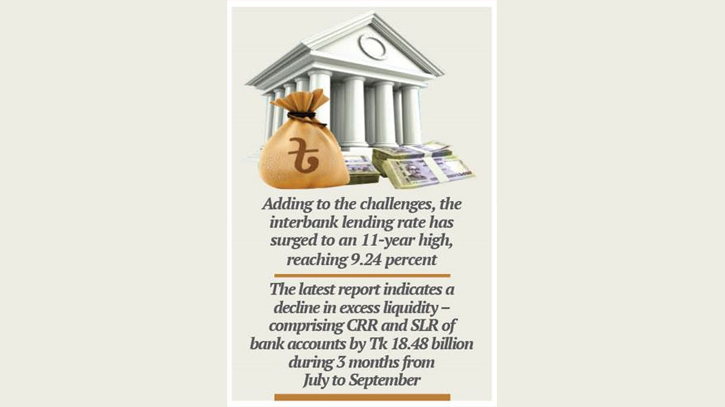
Photo: Messenger
The banking sector's surplus liquidity in the initial quarter of the current fiscal year has decreased by approximately Tk 69 billion or 6900 crores.
This reduction in liquidity comes at a time when banks are not witnessing significant deposit inflows, thereby limiting their lending capacity. The liquidity crisis has compelled many banks to regularly borrow from the Bangladesh Bank.
Adding to the challenges, the interbank lending rate has surged to an 11-year high, reaching 9.24 percent. Consequently, a majority of banks are engaging in their day-to-day operations by relying on high-interest loans. This information is derived from an updated report provided by the Bangladesh Bank, highlighting the current strain on liquidity in the banking sector.
The latest report indicates a decline in the excess liquidity – comprising Cash Reserve Ratio (CRR) and Statutory Liquidity Ratio (SLR) of bank accounts by Tk 18.48 billion during the three-month period from July to September. The excess liquidity, which was Tk 1662.88 billion at the end of June, decreased to Tk 1644.40 billion by the end of September. However, within one month following September, it further decreased by Tk 50.48 billion or 5048 crores.
Economists have expressed concerns over the rapid reduction of excess liquidity, as such a quick decrease may pose challenges. The decline in excess liquidity within a short timeframe may impact the banking sector's ability to manage funds effectively and meet lending demands, prompting apprehension among economists.
According to central bank data, the contractionary policy implemented by the Bangladesh Bank is proving effective in curbing inflation. In the first three months of FY 2023-24 (July-September), there has been a decrease in money supply, indicating a contractionary monetary policy. The money supply has contracted by 0.53 percent in this quarter compared to the previous one.
As of now, the currency market has a supply of Tk 18772.46 billion, falling short of the target. The central bank mentioned that the decrease in foreign currency is a significant factor contributing to the lower-than-targeted growth in money supply. The money supply target for December was set at 9.50 percent, but the current figures reflect a deviation from this goal due to the mentioned factors.
During the quarter under discussion, the domestic debt of the country has risen to Tk 19 lakh crores, marking a 0.20 percent increase compared to the previous April-June quarter. However, this growth has been subdued due to the low expansion of private-sector credit, which has also led to a decline in public-sector credit growth. Consequently, the overall gross domestic credit growth has fallen significantly below the targeted and actual growth rates observed in previous years.
At the conclusion of the first quarter of the year, the government's net debt from the banking sector has witnessed a 26.81 percent increase, compared to 28.54 percent at the end of the same period in the previous year. The decrease in bank lending is attributed to the government's undertaking of various mega projects. Meanwhile, in the private sector, credit growth stood at 9.69 percent by the end of the first quarter.
During the same period, there has been a decline in reserves. In comparison to the last quarter of the fiscal year 2022-23, reserves have decreased by 10.26 percent in the first quarter of the current year. Reserves that were Tk 3835.85 billion at the end of June reduced to Tk 3442.34 billion by the end of September, reflecting a decline of Tk 393.51 billion. Additionally, foreign loans and aid have also decreased during this period.
The rate of defaulted loans is reported to have experienced a slight decrease amid challenging economic conditions. As of the end of September, defaulted loans amounted to over Tk 1.55 lakh crore, constituting 9.93 percent of the total disbursed loans. The defaulted loan rate decreased by 0.18 percent compared to the previous quarter.
In addition, it has been highlighted that despite the current account of the trade balance being quoted for the period of July-September 2023, the total trade balance shows a financial deficit of 285 million dollars. This deficit is exerting negative pressure on foreign exchange reserves, further exacerbating the challenges posed by the devaluation of the Taka-Dollar exchange rate.
A source-based analysis of money supply reveals that at the end of the July-September quarter, net foreign assets experienced a decline of 7.39 percent, while net domestic assets increased by .86 percent. The annualised growth rate of broad money supply (M2) at the end of September 2023 stood at 8.96 percent. Although this is lower than the December 2023 target of 9.50 percent, it is higher than the growth rate observed during the same period last year.
The lower-than-target growth in money supply is primarily attributed to the decline in net foreign assets. This decline is mainly a result of the deficit in the current account balance, despite a decrease in import expenditure, which is identified as the primary factor contributing to the below-target growth in money supply.
Messenger/Sun Yath








